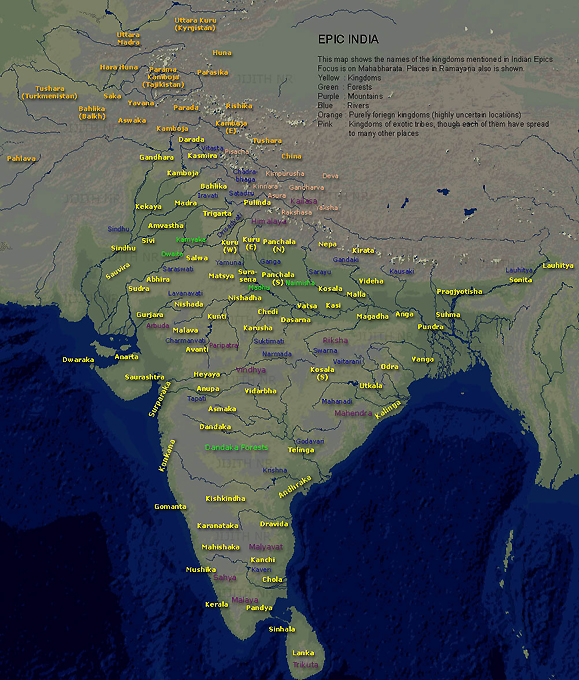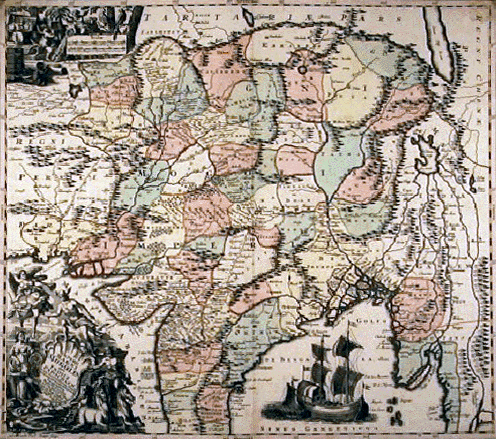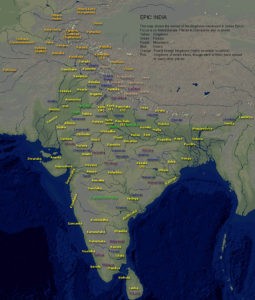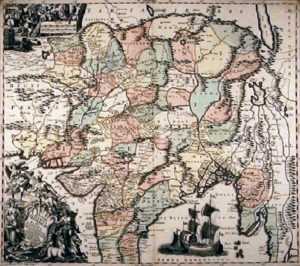Ancient Gaudadesh

May 08, 2018 — CANADA (SUN) —
Throughout Vaisnava literature we find frequent mention of Gauda-desa and Gauda-mandala-bhumi, sacred places where Sri Krsna Caitanya enacted His transcendental pastimes. This verse describes the Appearance of Sri Sri Gaura-Nitai in Gauda:
Caitanya-caritamrta Adi lila 1.102:
ei candra surya dui parama sadaya
jagatera bhagye gaude karila udaya
“These two, the sun and moon, are very kind to the people of the world. Thus for the good fortune of all, They have appeared on the horizon of Bengal.
PURPORT
The celebrated ancient capital of the Sena dynasty, which was known as Gaudadesa or Gauda, was situated in what is now the modern district of Maldah. Later this capital was transferred to the ninth or central island on the western side of the Ganges at Navadvipa, which is now known as Mayapur and was then called Gaudapura. Lord Caitanya appeared there, and Lord Nityananda came there and joined Him from the district of Birbhum. They appeared on the horizon of Gaudadesa to spread the science of Krsna consciousness, and it is predicted that as the sun and moon gradually move west, the movement They began five hundred years ago will come to the Western civilizations by Their mercy.”
(Caitanya-caritamrta Adi lila 1.102)
In his purport to Caitanya-caritamrta Adi lila 1.19, Srila Prabhupada gives a comprehensive explanation of the territory known as Gauda, and how it relates to our Gaudiya Vaisnava Sampradaya:
“Gaudiya indicates the part of India between the southern side of the Himalayan Mountains and the northern part of the Vindhya Hills, which is called Aryavarta, or the Land of the Aryans. This portion of India is divided into five parts or provinces (Panca-gaudadesa): Sarasvata (Kashmir and Punjab), Kanyakubja (Uttar Pradesh, including the modern city of Lucknow), Madhya-gauda (Madhya Pradesh), Maithila (Bihar and part of Bengal) and Utkala (part of Bengal and the whole of Orissa). Bengal is sometimes called Gaudadesa, partly because it forms a portion of Maithila and partly because the capital of the Hindu king Raja Laksmana Sena was known as Gauda. This old capital later came to be known as Gaudapura and gradually Mayapur.
The devotees of Orissa are called Udiyas, the devotees of Bengal are called Gaudiyas, and the devotees of southern India are known as Dravida devotees. As there are five provinces in Aryavarta, so Daksinatya, southern India, is also divided into five provinces, which are called Panca-dravida. The four Vaisnava acaryas who are the great authorities of the four Vaisnava disciplic successions, as well as Sripada Sankaracarya of the Mayavada school, appeared in the Panca-dravida provinces. Among the four Vaisnava acaryas, who are all accepted by the Gaudiya Vaisnavas, Sri Ramanuja Acarya appeared in the southern part of Andhra Pradesh at Mahabhutapuri, Sri Madhva Acarya appeared at Pajakam (near Vimanagiri) in the district of Mangalore, Sri Visnu Svami appeared at Pandya, and Sri Nimbarka appeared at Mungera-patana, in the extreme south.
Sri Caitanya Mahaprabhu accepted the chain of disciplic succession from Madhva Acarya, but the Vaisnavas in His line do not accept the Tattva-vadis, who also claim to belong to the Madhva-sampradaya. To distinguish themselves clearly from the Tattva-vadi branch of Madhva’s descendants, the Vaisnavas of Bengal prefer to call themselves Gaudiya Vaisnavas. Sri Madhva Acarya is also known as Sri Gauda-purnananda, and therefore the name Madhva-Gaudiya-sampradaya is quite suitable for the disciplic succession of the Gaudiya Vaisnavas. Our spiritual master, Om Visnupada Srimad Bhaktisiddhanta Sarasvati Gosvami Maharaja, accepted initiation in the Madhva-Gaudiya-sampradaya.”
(Srila Prabhupada’s Purport to Caitanya-caritamrta Adi lila 1.19)

Ancient Bengal
Following his South India tirtha-yatra, Lord Caitanya’s association with the Goswamis, Srila Rupa and Srila Sanatana, is described by Srila Prabhupada in his Prologue to Teachings of Lord Caitanya, which also gives some interesting information on Gauda:
“Upon his return to Puri, Raja Prataparudra-deva and several pandita brahmanas joined the banner of Caitanya Mahaprabhu. He was now twenty-seven years of age. In his twenty-eighth year he went to Bengal as far as Gauda in Malda. There he picked up two great personages named Rupa and Sanatana. Though descended from the lines of the Karnatic brahmanas, these two brothers turned demi-Moslems by their continual contact with Hussain Shah, the then Emperor of Gauda. Their names had been changed by the Emperor into Dabira Khasa and Sakara Mallika, and their master loved them heartily since they were both learned in Persian, Arabic and Sanskrit and were loyal servants of the state. The two gentlemen had found no way to come back as regular Hindus and had written to Mahaprabhu for spiritual help while he was at Puri. Mahaprabhu had written in reply that he would come to them and extricate them from their spiritual difficulties. Now that he had come to Gauda, both the brothers appeared before him with their long-standing prayer. Mahaprabhu ordered them to go to Vrndavana and meet him there.”
(Teachings of Lord Caitanya, Prologue)
Modern historians have provided further details on the history and geographic territory of Gauda desa, such as this explanation written by Suchandra Ghosh for Banglopedia:
“Gauda (Janapada) was an important geographical entity in ancient and medieval Bengal. The Arthashastra refers to it along with Vanga, Pundra and Kamarupa. Though the geographical limit of the Gauda country is not mentioned, the fact that it is linked with Vanga and Pundra definitely indicates its location in eastern India. Vatsayana (3rd-4th century A.D.) was familiar with this country. This geographical idea continues even in the Puranas, as it is regarded as one of the Janapadas of the eastern quarter.
Varahamihira (circa 6th century A.D.) was also aware of Gauda Janapada. In his Brhat Samhhita he mentions six distinct Janapadas: Gaudaka, Paundra, Vanga, Samatata, Vardhamana and Tamralipta. It appears from his narration that Murshidabad, Birbhum, and western Burdwan formed the territory of ancient Gauda.
The earliest epigraphic evidence referring to the territory of the Gauda people is the Haraha inscription of the Maukhari ruler, Ishanavarman, which is datable to 554 A.D.. It is stated in the inscription that Ishanavarman defeated the Gaudas who live near the sea (Gaudan samudrashrayan). This statement finds corroboration in the undated Gurgi inscription of Prabodhashiva (circa 11th c. A.D.) which describes the Lord of Gauda as ‘lying in the watery fort of the sea’ (jalanidhi jaladurggam gauda rajo dhishete). The evidence of these two epigraphs drives home the fact that the Gaudas, at least at one point of history, lived in the coastal region.
With the passage of time and change in the political scenario the connotation of Gauda, however, underwent changes. The rise of Shashanka, the ruler of Gauda, as a formidable power in the early part of the 7th century A.D. definitely led to the extension of the territorial limits of Gauda. From the accounts of Hiuen-tsang we learn that he travelled from the country of Karnasuvarna to a region in coastal Orissa, and the area was ruled by Shashanka. Obviously, the territory of Karnasuvarna stretched up to littoral West Bengal.
Interestingly, this king Shashanka is described in Banabhatta’s Harsacharita as the Lord of Gauda, whose capital was at Karnasuvarna. In fact, Bana castigates him as Gauda Bhujanga (the dangerous Gauda snake). Thus in the early part of the 7th century, Gauda and Karnasuvarna were co-terminous. On the basis of Hiuen Tsang’s itinerary and the archaeological remains of Raktamrittika Mahavihara, Karnasuvarna, the capital city of Gauda kingdom has been located near Chiruti in Murshidabad district of West Bengal. Hence Murshidabad formed the core area of Gauda.
The political limits of the geographical name Gauda further extended to the region of north Bengal, i.e., Pundravardhana. From the Aryamanjushri Mulakalpa we learn that Pundravardhana was ruled by Shashanka. This statement finds corroboration in the allusion to a struggle in the Dubi plates between Susthitavarman and Bhaskarvarman of Kamarupa on the one side, and the king of Gauda on the other. As a ruler, Bhaskarvarman’s contemporary was Shashanka. The struggle might have taken place in north Bengal. We know from Hiuen Tsang that Pundravardhana and Kamarupa were contiguous territories. Thus Gauda under Shashanka embraced parts of West Bengal, including its coasts, and North Bengal, at least for a short time.
The appellation Gauda was applied even to areas outside Bengal. It was used in a political sense in the Gaudavaho of Vakpati. In Vakpati’s account, Magadha was included within the realm of the Gauda ruler.
In the early medieval period, the term Gauda had a wider connotation. The Rastrakuta and the Pratihara records styled the Pala rulers as Gaudeshvara, Gaudendra, Gaudaraja, etc. This obviously implies that the name Gauda, which originally denoted parts of West Bengal, became so diffused that during the 8th and 9th centuries it was sometimes synonymous with the entire Pala Kingdom.
We come across the term Pancha Gauda for the first time in the famous historical chronicle of Kashmir, the Rajatarangini of Kalhana. This indicates the widest diffusion of the name Gauda. Pancha Gauda referred to Gauda in association with Sarasvata, Kanyakubja, Mithila, and Utkala.
It thus appears that originally Gauda Janapada lay to the west of Bhagirathi and that its core area was Murshidabad. Gradually, with the increase of the political might of Shashanka, the first independent ruler of Gauda in the early part of the 7th century A.D., the political limits of Gauda extended, stretching in the south to coastal Orissa and the north to Pundravardhana.
In the 13th century, Gaur under the Bengal Sultans denoted the entire area of the sultanate. Its capital, also called Gaur, stood at the site previously known as Laksmanavati, and renamed Lakhnauti by the Muslim sultans.”
REFERENCES:
Amitabh Bhattacharyya, Historical Geography of Ancient and Early Medieval Bengal, Calcutta, 1977
DC Sircar, Gauda, Indian Historical Quarterly, 28, 123-34.





Leave a Reply